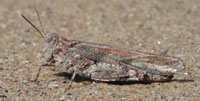Lake Huron Grasshopper
Scientific name: Trimerotropis huroniana

Cover photo credit: Allan Harris
Status
Threatened
"Threatened" means the species lives in the wild in Ontario, is not endangered, but is likely to become endangered if steps are not taken to address factors threatening it.
Date added to the Species at Risk in Ontario List
June 2, 2017.
Read the assessment report (PDF)
What it looks like
The Lake Huron Grasshopper is silver-grey to brown in colour with speckles and banding on its front wings that help it to blend in with its sandy habitat. When the species takes flight, its hind wings become visible and have clear or pale yellow areas at the base, a black band across the middle, and clear or smoky tips. The females range in size from 29 to 40 mm and are larger than the males which range in size from 24 to 30 mm.
Where it lives
The Lake Huron Grasshopper lives exclusively in open dune habitat along the shores of Lake Huron, Lake Michigan and Lake Superior. Its preferred habitat is the foredune, the low ridge of open bare sand covered with scattered grasses and located closest to the lake.
Where it’s been found in Ontario
This grasshopper is known to occur at eight locations in Ontario. One is located on Pancake Bay on southern Lake Superior, one on Great Duck Island, Lake Huron and the rest are found on Manitoulin Island along the shores of Lake Huron. The species was once found farther south in Ontario with historic records from Wasaga and Sauble beaches as well as Giant’s Tomb Island.
What threatens it
The most significant threat to the Lake Huron Grasshopper is habitat loss caused by both residential and commercial development and intensive recreational use, which destroys or damages dune habitat.
Recreational use by pedestrians and off-road vehicles can harm dune habitats by damaging the vegetation which stabilizes the dunes and causing dune blowouts (depressions caused by erosion of sand by wind).
Invasive plants, especially Common Reed and Spotted Knapweed can replace preferred food plants and alter the natural processes that allow the dune to exist.
Changes in lake levels related to climate change, natural cycles, or lake level management have the potential to reduce the amount of dune habitat.
Action we are taking
Threatened species and their general habitat are automatically protected.
Recovery strategy
A recovery strategy advises the ministry on ways to ensure healthy numbers of the species return to Ontario.
Read the executive summary and the full document (December 7, 2018).
Government response statement
A government response statement outlines the actions the government intends to take or support to help recover the species.
Read the government response statement (September 5, 2019).
Review of progress
A review of progress made toward protecting and recovering a species is required no later than the time specified in the species’ government response statement, or not later than five years after the government response statement is published if no time is specified.
Read the report on progress towards the protection and recovery of 12 species at risk, including Lake Huron Grasshopper (2024).
Report a sighting
Report a sighting of an endangered animal or plant to the Natural Heritage Information Centre. Photographs with specific locations or mapping coordinates are always helpful.
Volunteer
Volunteer with your local nature club or provincial park to participate in surveys or stewardship work focused on species at risk.
Be a good steward
Private land owners have a very important role to play in species recovery. If you find Lake Huron Grasshopper on your land, you may be eligible for stewardship programs that support the protection and recovery of species at risk and their habitats.
Report illegal activity
Report any illegal activity related to species at risk to
Quick facts
- The shores of Lake Huron, Lake Michigan and southern Lake Superior are the only places in the world that Lake Huron Grasshopper can be found.
- It only lives in open dune habitats where its preferred food plants are located.